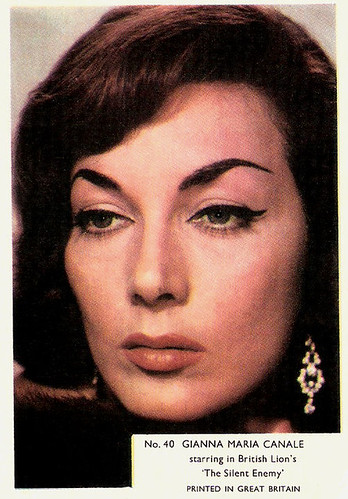
French postcard by Editions P.I., Paris, no. 625, 1953. Photo: MGM (Metro Goldwyn Mayer).

French postcard. Photo: MGM (Metro Goldwyn Mayer).

Italian postcard.
Miss Calabria
Gianna Maria Canale was born of Greek descent in Reggio Calabria, in the south of Italy, in 1927. When she was working as a steno typist, her film career started with a small role in the film Aquila Nera/Return of the Black Eagle (Riccardo Freda, 1946) starring Rossano Brazzi.
The next year she entered as Miss Calabria the now legendary Miss Italia 1947 contest. Lucia Bosè became Miss Italia, but Canale placed second before three other gorgeous, future film stars, Gina Lollobrigida, Eleonora Rossi-Drago and Silvana Mangano.
After the beauty contest, Canale received publicity in many Italian magazines that compared her sultry, dark-haired looks to those of Ava Gardner. Egyptian-born director Riccardo Freda (aka Robert Hampton), who had directed her in Aquila Nera, offered her a film contract and a role opposite Vittorio Gassman in Il cavaliere misterioso/The Mysterious Cavalier (Riccardo Freda, 1948).
In this film, she had a nude scene. During the shooting, the director and his leading lady fell in love. Freda left his wife and he and Canale got married in Brazil. There they shot two films, Guarany (Riccardo Freda, 1948) and O Caçula do Barulho (Riccardo Freda, 1949).
Canale could not get used to the South American climate and they returned to Italy. There she was often directed by her husband in such films as Il conte Ugolino/Count Ugolino (Riccardo Freda, 1949) with Carlo Ninchi, Il figlio di d'Artagnan/The Son of D’Artagnan (Riccardo Freda, 1950) again with Ninchi, and Vedi Napoli e poi muori/See Naples and Die (Riccardo Freda, 1951). In their Black Eagle sequel La vendetta di Aquila Nera/The Revenge of the Black Eagle (Riccardo Freda, 1951) she was now the leading lady opposite Rossano Brazzi.

Romanian postcard by Casa Filmului Acin. Collection: Alina Deaconu.

Romanian minicard (collectors card). Photo: Lux Film. Gianna Maria Canale in Teodora, imperatrice di Bisanzio/Theodora, Slave Empress (Riccardo Freda, 1954).

German postcard by Ufa (Universum-Film Aktiengesellschaft), Berlin-Tempelhof, no. FK 4259. Retail price: 25 Pfg. Photo: Columbia Film. publicity still for The Whole Truth (John Guillermin, 1958).
Queen of the Peplum
In 1951, Gianna Maria Canale played a supporting role in the American war film Go for Broke! (Robert Pirosh, 1951) starring Van Johnson. Director, Robert Pirosh wrote his own script, a tribute to Japanese-American volunteers fighting in World War II. Canale continued to appear in Italian films, but she also starred in such international films as the Film Noir Dramma nella Kasbah/The Man From Cairo (Ray Enright, 1953) starring George Raft, Madame du Barry (Christian-Jaque, 1954) with Martine Carol, and Napoléon (Sacha Guitry, 1955).
In Italy, she starred in many Peplums or Sandaloni - sword and sandal films - including the first Hercules film Le fatiche di Ercole/Hercules (Pietro Francisi, 1958) which featured her as the Queen of the Amazons opposite bodybuilder Steve Reeves. At AllMovie, critic Hal Erickson calls her “A practitioner of the ‘enigmatic femme fatale’ school of screen performing (...) Most of Canale's film appearances were exotic to the point of self-mockery”, as witness Teodora, imperatrice di Bisanzio/Theodora Slave Empress (Riccardo Freda, 1954) and La Venere dei pirati/Queen of the Pirates (Mario Costa, 1961).
I vampiri/Evil's Commandment (1956) was her last film with Freda, and during the shooting, they separated. I vampiri, the first Italian horror film of the sound era, was completed by future Italian fantasy specialist Mario Bava. In this stylish and elegant fantasy, she plays Duchess Giselle du Grand who is kept alive with blood experiments.
Canale continued to appear in international films, including the biopic The Silent Enemy (William Fairchild, 1958) with Laurence Harvey as the controversial British war hero Lionel Crabb, and the thriller The Whole Truth (John Guillermin, 1958) as a temperamental Italian film star/murdered mistress of Stewart Granger. One of the most interesting of her later films was Il boom (Vittorio de Sica, 1963), a sombre comedy with Alberto Sordi that was sadly overlooked.
Gianna Maria Canale retired from the film industry in 1964. What happened then with her? Most of our sources only indicate that she became the widow of Riccardo Freda in 1999 and that Canale herself died in Florence in 2009, aged 81.

British collectors card, no. 40. Publicity still for The Silent Enemy (William Fairchild, 1958).

East-German postcard by VEB Progress Film-Vertrieb, Berlin, no. 2916, 1967. Retail price: MDN 0,20. Photo: Progress. Publicity still for Le chevalier de Pardaillan/Clash of Steel (Bernard Borderie, 1962).
La Diva. A Tribute by Orazio Garofalo. Source: oraziogarofalorende (YouTube).
Sources: Hal Erickson (AllMovie), Glamour Girls of the Silver Screen, Wikipedia and IMDb.
This post was last updated on 8 September 2023.
No comments:
Post a Comment